In ‘UFO Cover-Up Allegations: Pentagon’s Firm Denial and the Ongoing UAP Debate,’ we’re diving headfirst into the swirling vortex of mystery and skepticism surrounding Unidentified Aerial Phenomena. Buckle up as we unravel the Pentagon’s staunch denials against a backdrop of persistent conspiracy theories and public fascination. Get ready for an eye-opening journey through a world where fact and fiction collide spectacularly.
Introduction to the UAP Phenomenon and Pentagon’s Stance
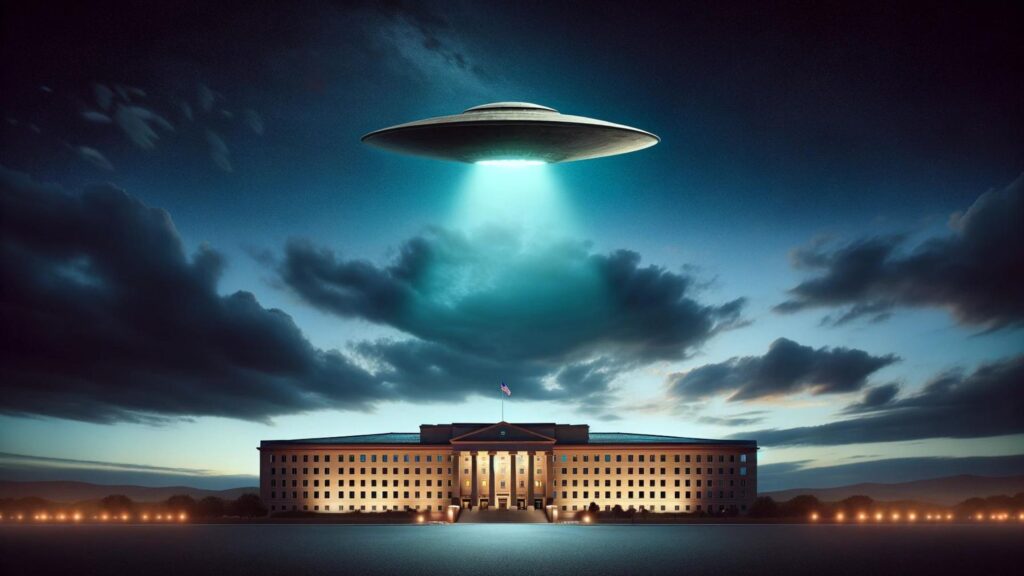
Introduction to UAP: Unveiling the Mystery
What are Unidentified Aerial Phenomena (UAP)?
Let’s dive into the world of Unidentified Aerial Phenomena, or UAP, as they’re commonly known. Gone are the days when the term ‘UFO’ was the go-to. Nowadays, UAP is the preferred nomenclature, broadening the scope beyond just ‘flying objects’ to include a whole range of mysterious sightings in the sky. But what exactly are they? In essence, UAP refers to aerial occurrences that defy immediate explanation. Think of them as puzzles in the sky – they could be anything from unusual weather patterns to cutting-edge technology and, yes, even the possibility of extraterrestrial life.

A Glimpse into the Past: The Historical Context
The intrigue surrounding UAP isn’t a modern phenomenon. It’s a curiosity that has spanned decades, dating back to World War II when pilots reported seeing ‘foo fighters’ – mysterious and fast-moving lights in the sky. Fast forward to 1947, the term “flying saucer” entered public lexicon following the famous Roswell incident, where a supposed alien spacecraft was believed to have crashed in New Mexico.
However, the U.S. government’s interest in these phenomena isn’t just a reaction to public curiosity. It’s a well-documented journey starting with Project Blue Book, an Air Force program initiated in 1952 and concluding in 1969. This project, aimed at studying UFOs, compiled a staggering 12,618 reports. While most were identified, a small fraction remained unexplained, fueling public intrigue and skepticism.

The Rise of Public Interest and Conspiracy Theories
The undying public interest in UAP is as mysterious as the phenomena themselves. From the pages of sci-fi novels to the screens of Hollywood blockbusters, UAP has captured our collective imagination. They are not just subjects of entertainment but have also sparked a multitude of conspiracy theories. These range from government cover-ups, like the alleged concealment of UFO crash evidence in Roswell, to the controversial Area 51 – a mecca for conspiracy theorists who believe it’s a hotspot for alien technology research.
It’s a topic that transcends simple curiosity, tapping into our fundamental need to understand our place in the universe. Are we alone? Are these phenomena mere quirks of nature, or is there a greater mystery waiting to be unraveled? The UAP debate, enriched by a mix of declassified reports, eyewitness accounts, and unshakeable conspiracy theories, continues to be a magnet for public fascination.
As we embark on this journey to explore the depths of UAP, keep in mind that the truth, as they say, might be out there. And perhaps, in understanding these enigmatic phenomena, we might uncover more about our world, our universe, and ourselves.
Stay tuned as we delve deeper into this enigma, piecing together the puzzle that has captivated minds for generations. What will we discover next in the ever-evolving narrative of Unidentified Aerial Phenomena?
Overview of the Pentagon’s Position on UAP

The Pentagon’s Firm Stance: No Extraterrestrial Evidence
The Pentagon has long been at the center of the UAP conversation, wielding a mix of skepticism and scientific rigor. In a decisive move, echoing through the halls of conspiracy and speculation, the Pentagon has firmly denied any evidence of extraterrestrial findings in its UAP investigations. This stance isn’t just a casual remark; it’s a well-considered position grounded in extensive research and analysis.
Let’s put this into context. Think back to the numerous UAP sightings reported by military personnel – each incident meticulously analyzed. Yet, despite the advanced technology and expertise at their disposal, the Pentagon has consistently found conventional explanations for these phenomena. From misidentified atmospheric conditions to cutting-edge aircraft, the explanations are often mundane but grounded in reality.

Birth of the All-domain Anomaly Resolution Office (AARO)
In a pivotal moment in July 2022, the Pentagon established the All-domain Anomaly Resolution Office (AARO), a significant step in its commitment to understanding UAP. This wasn’t just another bureaucratic entity; it was a clear signal of the seriousness with which the Pentagon approached the UAP phenomenon.
AARO’s mission is multidimensional. It’s not just about identifying these anomalies but also about understanding the potential threats they pose to national security and air safety. AARO operates under a mantle of scientific inquiry and intelligence analysis, aiming to demystify these phenomena through empirical evidence and rigorous research.
The creation of AARO marks a new era in UAP investigations – one where transparency, scientific rigor, and inter-agency collaboration take center stage. This move by the Pentagon isn’t just about debunking myths or confirming theories; it’s about instilling a methodical approach to a historically sensationalized topic.
As we continue our exploration of the UAP enigma, the role of AARO and the Pentagon’s unwavering position will undoubtedly be pivotal. What mysteries will unravel under their scrutiny? The journey into the unknown continues, guided by a beacon of scientific inquiry and a relentless pursuit of truth.
Stay tuned as we further investigate and unravel the complex tapestry of UAP, guided by the Pentagon’s analytical approach. What new insights and discoveries await us in this unfolding narrative?
Analysis of Historical UAP Investigations: Unraveling the Government’s Quest

Tracing the Roots: Major U.S. Government UAP Investigatory Programs
The enigmatic journey of UAP investigations by the U.S. government isn’t just a tale of the modern era; it’s a saga that dates back to 1945. Each program embarked on a unique mission, shaping our understanding of the unexplained aerial phenomena.
- Project SAUCER/Project SIGN (1946/1947–February 1949): This early endeavor marked the U.S. government’s initial formal attempt to understand UAPs. Originally dubbed Project SAUCER, it evolved into Project SIGN, aiming to determine whether these unidentified objects posed a threat to national security. The project concluded most UAPs were misidentifications of natural phenomena, yet it left the door open to extraterrestrial possibilities.
- Project GRUDGE (February 1949–1951): Succeeding Project SIGN, Project GRUDGE took a more skeptical approach. With a focus on debunking UFO reports, it largely viewed these phenomena as explainable misinterpretations.
- Project BLUE BOOK (1952–1969): The most famous of all, Project Blue Book, spearheaded by the U.S. Air Force, was a systematic study of UAPs. Compiling over 12,000 reports, it classified a significant majority as misidentifications or natural occurrences, while approximately 700 reports remained unexplained.
- The Robertson Panel (January 1953): Convened by the CIA, this panel reviewed the findings of previous projects. It concluded there was no evidence of a national security threat and recommended that the government demystify UFO reports to calm public hysteria.
- The Condon Report (1968): Undertaken by the University of Colorado and funded by the Air Force, this study echoed similar findings – no UFO reported, investigated, or evaluated indicated any advanced technology beyond contemporary understanding.
Deciphering the Key Conclusions
Across these varied investigations, a common theme emerged: a majority of UAPs could be attributed to mundane causes – atmospheric conditions, conventional aircraft, or astronomical objects. However, the unsolved residue of reports fueled an enduring enigma. The implication that not all phenomena could be easily explained kept the door ajar to other possibilities, be they technological breakthroughs or something beyond our current scientific grasp.
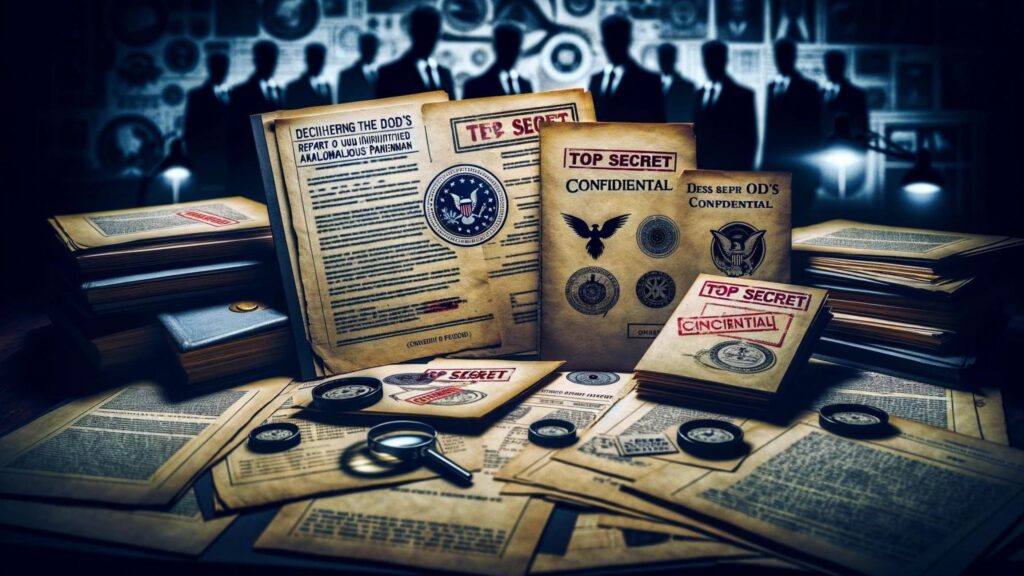
The Ripple Effect on Public Perception
The impact of these findings on public perception has been profound and multifaceted. Each release of information or conclusion drawn by these programs sent ripples through the public discourse. The idea that some UAPs remained unexplained captured the public’s imagination, leading to a plethora of theories, some grounded in scientific curiosity and others in the realm of science fiction.
The balance between national security interests and public transparency has been a delicate dance. While these investigations aimed to demystify UAPs, the very nature of their inconclusive findings, coupled with the government’s initially secretive approach, only deepened public fascination and skepticism. This dichotomy has been a driving force in the ongoing debate and interest in UAPs, demonstrating that the phenomenon is not just a scientific or defense issue but deeply ingrained in the cultural fabric.
As we continue to explore this subject, remember: the journey into understanding UAPs is as much about the unknowns we seek to unravel as it is about the reflections they cast on our society and ourselves. Stay tuned for more insights into this compelling chapter of aerial mysteries.
Challenges in Investigating UAP: Navigating the Maze of Uncertainty

The Quest for High-Quality, Actionable Data
When it comes to investigating Unidentified Aerial Phenomena (UAP), one of the most formidable challenges is obtaining high-quality, actionable data. Picture this: UAP sightings are often brief, unexpected, and come with limited physical evidence. This makes the data collection sporadic and often reliant on eyewitness accounts, which, while valuable, can be subjective and influenced by personal biases and perception.
Moreover, the fleeting nature of these phenomena means that even with advanced monitoring equipment, capturing them in enough detail for comprehensive analysis is akin to finding a needle in a haystack. Reports from pilots, radar operators, and satellite data offer pieces of a vast puzzle, but the quality and depth of this information vary greatly. In essence, the UAP investigative landscape is littered with data gaps, leaving researchers to piece together an incomplete jigsaw puzzle.
Limitations in Technology and Human Interpretation
The technological aspect of UAP investigation is a double-edged sword. On the one hand, advancements in radar, imaging, and aerial monitoring technologies have enhanced our ability to detect and track anomalous aerial activities. On the other hand, these technologies are not specifically designed for UAP detection, which means they might not capture the necessary details or might misinterpret natural phenomena as unexplained objects.
Furthermore, human interpretation plays a crucial role in analyzing UAP data. However, this is where another challenge arises. Human analysis is subject to perceptual errors and cognitive biases. For example, what one expert might classify as an unexplainable anomaly, another might attribute to a rare atmospheric event or a classified military experiment.
This interplay of technological limitations and human interpretation factors makes the field of UAP investigation not only complex but also ripe for controversies and conflicting opinions. Researchers tread a fine line between skepticism and open-mindedness, often under the pressure of public scrutiny and expectation.
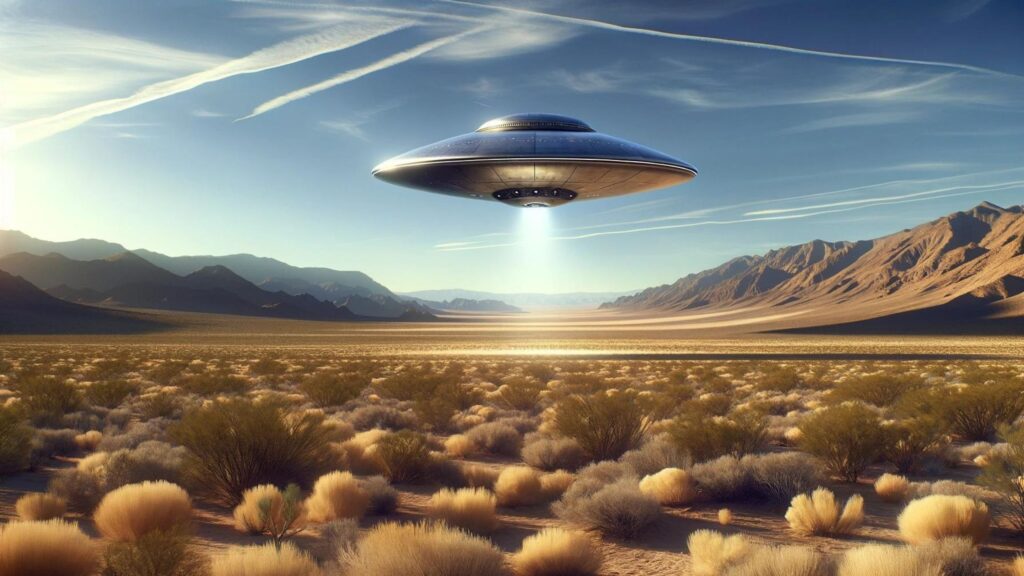
Looking Ahead: The Road to Clarity
As we delve deeper into the enigma of UAPs, the path forward is not just about collecting more data but improving how we collect, analyze, and interpret this data. This journey is as much about advancing our technological capabilities as it is about refining our analytical methodologies and understanding the human factors at play.
So, as we continue exploring this compelling realm, remember that each challenge in investigating UAPs brings us a step closer to understanding not just the phenomena themselves but also the limitations and potentials of our scientific and technological pursuits. Stay tuned, as the quest to unravel the mysteries of UAPs is bound to take us to new horizons of discovery and understanding.
Recent Developments, Findings, and Ongoing Debate
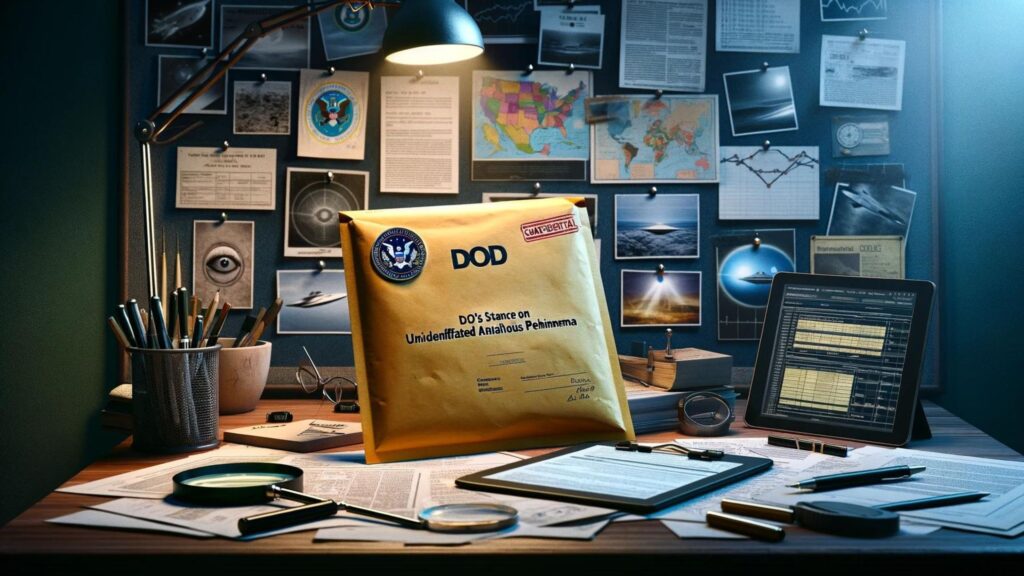
The Pentagon’s Recent Comprehensive UAP Report: A Deep Dive into 2024’s Revelations
Unpacking the DoD’s 2024 Report: Scope, Approach, and Methodologies
In 2024, the Pentagon released a groundbreaking report on Unidentified Aerial Phenomena (UAP), offering a new level of transparency and depth in its investigations. The scope of this report was unprecedented, covering all official U.S. Government (USG) investigatory efforts since 1945. It wasn’t just a collection of anecdotes and data; it represented a meticulous analysis conducted by the Department of Defense’s All-domain Anomaly Resolution Office (AARO).
The AARO’s methodology was robust and multidimensional, integrating a blend of scientific methods and intelligence analysis. It involved extensive research into classified and unclassified archives, the conduct of around 30 interviews, and collaboration with Intelligence Community (I.C.) and DoD officials. The report’s approach was empirical, relying on tangible evidence rather than speculation.
Key Findings: The Intrigue and Implications
The report debunked several long-standing theories and conjectures about UAPs. Crucially, no evidence was found confirming that any sighting represented extraterrestrial technology. This was a significant clarification, considering the rampant speculations that have prevailed for decades. The AARO meticulously analyzed numerous accounts, scrutinizing claims of USG involvement in hidden UAP programs. Most notably, it revealed:
- No Authentic UAP Nondisclosure Agreements: Disputing the claims of secret agreements threatening individuals for disclosing UAP information.
- CIA and Alleged UAP Experimentation: The report dismissed the involvement of a former CIA official in the movement of extraterrestrial technology.
- Misinterpretation of Authentic Non-UAP-Related Programs: Many interviewees misattributed regular military and intelligence operations to UAP-related activities.
The findings suggest a significant misinterpretation and misinformation spread over the years, often conflating advanced terrestrial technology and atmospheric phenomena with extraterrestrial encounters.

The Broader Implications
The implications of the DoD’s 2024 UAP report are far-reaching. Firstly, it provides a clearer understanding of the nature of UAPs, discounting alien theories and instead pointing towards more mundane explanations. This helps refocus the narrative on scientific inquiry and rational explanation.
Secondly, the report’s findings have a profound impact on public perception. It challenges long-held beliefs and conspiracy theories, potentially reshaping the public discourse on UAPs. However, it also leaves room for further exploration and study, as some phenomena remain unexplained.
Lastly, the comprehensive nature of the report sets a new standard for transparency and rigor in future UAP investigations. It demonstrates the government’s commitment to empirical evidence and thorough analysis, possibly paving the way for more open engagement with the public and scientific community on this enigmatic topic.
As we turn the page on these findings, the journey into the unknown continues. The DoD’s 2024 report, while answering some questions, undoubtedly opens new avenues of inquiry, reminding us that the quest for understanding UAPs is an ever-evolving pursuit. Stay tuned, as the story of UAPs is far from over.
Interviewee Claims and Pentagon’s Rebuttals: A Tug-of-War between Belief and Evidence
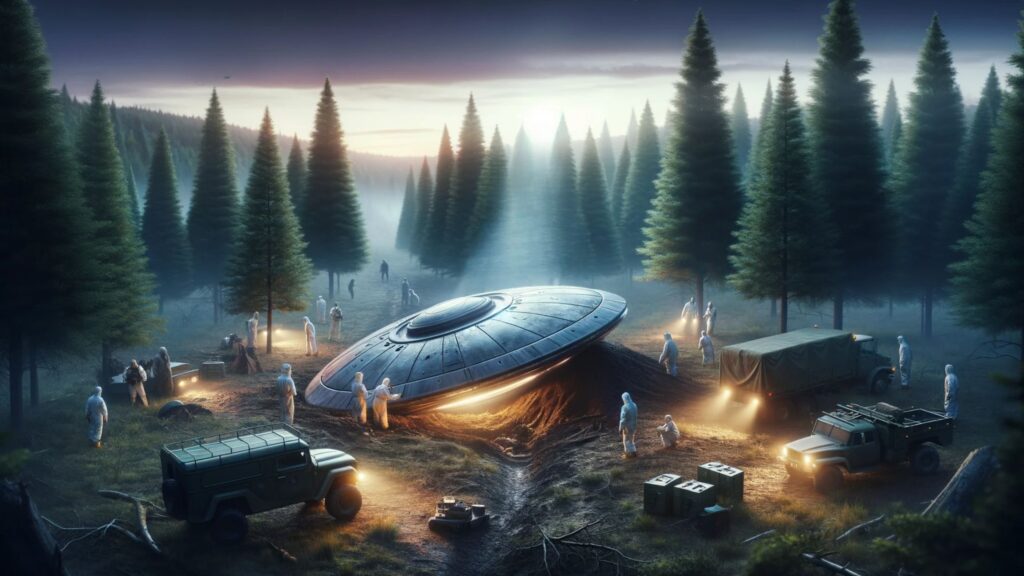
Unraveling the Tapestry of Claims
The realm of Unidentified Aerial Phenomena (UAP) is not just about sightings in the sky; it’s equally about the narratives woven by those who claim to have inside knowledge. Over the years, numerous interviewees have come forward with bold assertions about hidden UAP programs. These claims range from the U.S. Government possessing extraterrestrial technology to conducting covert reverse-engineering programs.
One of the most sensational claims involves the allegation that as many as 12 extraterrestrial spacecraft were recovered and hidden away from public scrutiny. Another intriguing assertion points to a former senior military officer who allegedly had physical interaction with an extraterrestrial spacecraft. These narratives, rich in detail and conviction, paint a picture of a vast, secretive network of UAP activity under the government’s umbrella.
The Pentagon’s Firm Stand: Debunking Myths with Facts
Facing these claims, the Pentagon has stood its ground with firm, evidence-based refutations. In response to the claim of 12 hidden spacecraft, the Department of Defense conducted thorough investigations and found no empirical evidence to support such assertions. The narrative of the military officer’s encounter with an alien spacecraft was also debunked, with the officer in question categorically denying the event.
Furthermore, in addressing the broader narrative of U.S. Government involvement in reverse-engineering alien technology, the Pentagon highlighted the lack of concrete evidence. The Department emphasized that while it takes every claim seriously, its conclusions are grounded in verifiable facts and rigorous analysis.
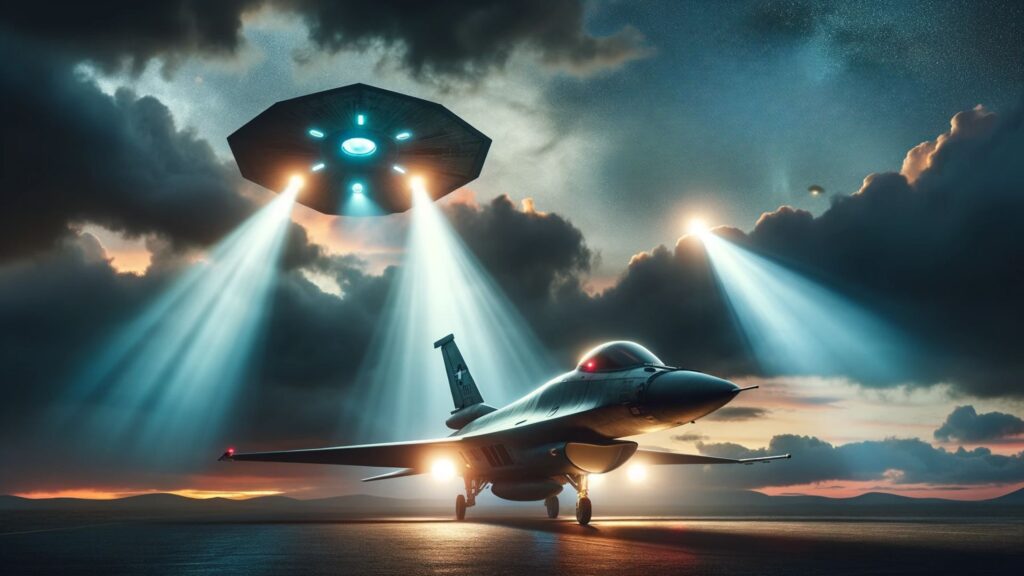
Between Belief and Skepticism: Navigating a Complex Landscape
This ongoing tug-of-war between interviewee claims and Pentagon rebuttals highlights a complex landscape where belief, skepticism, and the thirst for truth collide. It underscores the challenging nature of UAP investigations – a field where extraordinary claims require extraordinary evidence.
As we navigate through these contrasting narratives, the quest for understanding UAPs continues to be a blend of mystery and rational inquiry. The Pentagon’s stance is a reminder that in the pursuit of the unknown, evidence must be the guiding light. Stay tuned, as this intriguing dialogue between claims and rebuttals unfolds further, taking us deeper into the enigmatic world of UAPs.
International Perspectives and Comparisons: A Global UAP Inquiry

A Glimpse into UAP Investigations Around the World
While the U.S. has been at the forefront of investigating Unidentified Aerial Phenomena (UAP), this enigma has not been confined to American skies. Countries like the United Kingdom, Canada, and France have also embarked on their quests to unravel these aerial mysteries. Each nation’s approach provides unique insights and methodologies, contributing to a global understanding of UAPs.
The United Kingdom: A Blend of Skepticism and Scientific Inquiry
The U.K.’s involvement in UAP investigations dates back to the 1950s, with projects such as the “Flying Saucer Working Party” set up by the Ministry of Defence (MoD). This project, however, concluded that UFOs (as they were then called) posed no significant threat and were largely misinterpretations of ordinary objects.
Years later, the MoD ran a UFO desk, analyzing sightings from the public until 2009. These investigations, encapsulated in thousands of declassified documents, often leaned towards rational explanations, attributing most sightings to identifiable natural or man-made phenomena. The closure of this desk marked a shift in the U.K.’s official stance, suggesting a diminished concern about UAPs posing any real threat.
Canada: From Curiosity to Caution
Canada’s exploration into UAPs has been marked by a blend of scientific curiosity and cautious skepticism. Projects like “Magnet” and “Second Storey” in the 1950s reflected an early interest in the potential of UFOs being extraterrestrial in origin. However, over time, Canadian authorities have mirrored a more conservative approach, similar to the U.K., emphasizing explainable causes for such phenomena.

France: A Proactive and Ongoing Effort
In contrast to the U.K. and Canada, France has taken a notably proactive and ongoing stance towards UAP research. The French Space Agency’s unit, GEIPAN (Groupe d’Études et d’Informations sur les Phénomènes Aérospatiaux Non-identifiés), established in the 1970s, continues to function actively. GEIPAN’s approach has been methodical and scientific, categorizing sightings into four types and openly sharing data with the public. This transparency and ongoing commitment make France unique in the international UAP investigation landscape.
Methodologies: A Spectrum of Approaches
Comparing these international efforts reveals a spectrum of methodologies. While the U.K.’s approach has evolved from open inquiry to a more closed stance, Canada’s investigation has been intermittently active, largely dependent on public reporting. France stands out for its continuous and transparent scientific approach, offering a model that balances public interest with scientific rigor.
The Global UAP Tapestry: Diverse Threads of Inquiry
As we piece together this global tapestry of UAP inquiries, it’s evident that while methodologies and conclusions vary, the intrigue surrounding these phenomena is a universal constant. From the skeptical stance of the U.K. to the ongoing inquiries in France, these international efforts enrich our collective understanding of UAPs.
Stay tuned as we continue to explore how these diverse threads of inquiry from around the globe contribute to the ever-evolving narrative of Unidentified Aerial Phenomena.
Impact of Culture and Media: Shaping the UAP Narrative

The Media’s Role: From News to Sci-Fi
The journey of Unidentified Aerial Phenomena (UAP) through the lens of culture and media is a fascinating one. Media, in its various forms, has played a pivotal role in shaping public perception and the narrative surrounding UAPs. From the early news reports of “flying saucers” in the 1940s to the portrayal of UAPs in movies and T.V. shows, the media has been instrumental in bringing these phenomena into the public consciousness.
Movies like “Close Encounters of the Third Kind” and T.V. shows such as “The X-Files” have not only entertained but also sown seeds of curiosity, fear, and wonder about extraterrestrial life and unexplained aerial sightings. These portrayals, often blending fact with fiction, have significantly influenced public beliefs and attitudes toward UAPs. They’ve turned a scientific and defense-related issue into a cultural phenomenon, transcending the boundaries of mere curiosity.
Social Media and Online Platforms: Amplifying the UAP Discourse
In the modern digital era, the role of social media and online platforms in shaping the UAP narrative cannot be overstated. These platforms have become hotbeds for sharing sightings, theories, and discussions about UAPs. From YouTube videos capturing unexplained aerial phenomena to forums and social media groups dedicated to UFO research, the digital world has democratized the UAP discourse.
Social media has also played a crucial role in disseminating information – and misinformation. The viral nature of online content means that UAP sightings and theories can spread rapidly, often without the rigorous vetting typical of traditional media. This has led to a proliferation of varied and sometimes conflicting information, making it challenging for the public to discern fact from fiction.
The Double-Edged Sword of Digital Dissemination
While social media has empowered individuals to share experiences and information, it has also muddied the waters of credible UAP research. The ease of digital manipulation and the prevalence of fake or doctored content pose significant challenges to serious UAP inquiries. Navigating this complex digital landscape requires a discerning eye and a critical mind.

Conclusion: A Cultural and Digital Mosaic
As we delve deeper into the world of UAPs, it’s clear that the influence of culture and media is profound and far-reaching. They have turned UAPs from a niche interest into a mainstream topic, igniting global curiosity and debate. In this evolving narrative, the line between science and fiction often blurs, leaving us in a fascinating limbo filled with possibilities.
Stay tuned as we continue to explore this rich cultural and digital mosaic, where every piece – from a sci-fi film to a tweet – adds to the captivating puzzle of Unidentified Aerial Phenomena.
Scientific and Academic Standpoint: Demystifying UAPs Through the Lens of Science

Academic Perspectives on UAP Phenomena
In the realm of Unidentified Aerial Phenomena (UAP), the scientific and academic community plays a pivotal role, often serving as the bridge between unexplained mysteries and rational explanations. Renowned institutions and esteemed scholars have delved into the study of UAPs, approaching them with a mix of curiosity and scientific skepticism.
Historically, academia’s relationship with UAP phenomena has been cautious yet intriguing. While the popular narrative often veers towards the extraterrestrial and sensational, the academic perspective strives to ground it in empirical evidence and scientific rigor. Researchers from various disciplines, including astronomy, physics, and aeronautics, have contributed valuable insights, examining UAP sightings and incidents through the lens of known scientific principles.
The Role of Scientific Methods in UAP Investigations
The cornerstone of academic involvement in UAP studies is the application of scientific methods. This approach involves systematic observation, measurement, experimentation, and the formulation, testing, and modification of hypotheses. For instance, when evaluating UAP sightings, scientists might analyze radar data, pilot reports, and astronomical records to rule out conventional explanations like celestial bodies, atmospheric phenomena, or man-made objects.
One significant challenge in applying scientific methods to UAP investigations is the often limited and inconclusive data. Unlike traditional scientific research, UAP studies rarely have the luxury of controlled experiments or repeatable observations. As a result, much of the academic work in this field involves sifting through anecdotal evidence, historical records, and sporadic data to piece together plausible explanations.
Bridging the Gap Between Science and Mystery
Academic involvement in UAP research serves a critical function – it bridges the gap between mystery and understanding. By applying rigorous scientific analysis, scholars can separate fact from fiction, providing clarity amidst the sea of speculation. Their work not only aids in potentially identifying the nature of these phenomena but also advances our broader understanding of science, technology, and the universe.
As we navigate the complex and often contentious domain of UAPs, the scientific and academic standpoint remains a beacon of reason and exploration. Stay tuned as we continue to delve into this intersection of science and mystery, where each academic inquiry brings us closer to deciphering the true nature of Unidentified Aerial Phenomena.
The Future of UAP Research and Disclosure: Charting the Course Ahead

Charting New Directions in UAP Research
The field of Unidentified Aerial Phenomena (UAP) research stands at a crossroads, poised to venture into uncharted territories. As we look ahead, the future of UAP research seems primed to take on more sophisticated and multi-disciplinary approaches. The integration of advanced technologies like artificial intelligence for data analysis enhanced aerial surveillance systems, and perhaps even quantum computing could revolutionize how we study these phenomena.
Moreover, the potential for collaboration across various fields – from astrophysics to atmospheric sciences and even quantum mechanics – could provide new perspectives and deeper insights. As the mystery deepens, there’s a growing realization that solving the UAP puzzle may require tapping into a broader spectrum of scientific expertise.
Emphasizing Transparency and Public Engagement
Transparency and public engagement are set to play pivotal roles in the future of UAP research. As we’ve seen, the veil of secrecy historically shrouding this subject has often led to more questions than answers, breeding a fertile ground for speculation and conspiracy theories. Moving forward, there’s a clear need for open, honest communication between governmental agencies, researchers, and the public.
This openness not only serves to demystify UAPs but also helps in cultivating a more informed and engaged public discourse. It’s about building trust through transparency, ensuring that findings are shared, and the process of investigation is as open to scrutiny as possible. Public engagement through educational initiatives, open forums, and collaborative community projects could further help dispel myths and foster a more rational understanding of UAPs.
Looking Ahead: A New Era of Discovery and Understanding
The future of UAP research promises not just a quest for answers but also a journey towards greater understanding – of our world, our universe, and perhaps the very nature of reality. It’s a path that beckons with the promise of new discoveries and deeper insights, challenging us to look beyond our preconceived notions and biases.
So, as we stand on the brink of this new era in UAP research, let’s gear up for a journey that could redefine our understanding of the unknown. Stay tuned, for the road ahead is sure to be filled with intriguing discoveries, enlightening revelations, and, perhaps, the answers we have long sought about the mysteries in our skies.
Conclusion: Reflecting on the UAP Enigma and Its Broader Implications

Key Insights from the Pentagon’s Findings
The journey into the depths of Unidentified Aerial Phenomena (UAP) research, particularly highlighted by the Pentagon’s comprehensive reports, has been nothing short of an odyssey into the unknown. Key insights from these findings underscore a critical narrative: while most UAPs can be attributed to natural or human-made phenomena, a small yet significant portion remains unexplained. This conclusion, far from closing the book on UAPs, has opened new chapters of intrigue and scientific inquiry.
The Ongoing UAP Debate: More Than Meets the Eye
The debate around UAPs transcends the mere identification of these phenomena. It’s a conversation that challenges our understanding of the known and propels us to explore the boundaries of our scientific knowledge. The ongoing dialogue, fueled by a combination of declassified information, expert analysis, and public interest, has turned UAP research into a crucible for interdisciplinary study, blending aerospace technology, atmospheric science, and even psychology.
Implications for Science, National Security, and Public Understanding
The significance of these investigations extends into several key areas:
- Scientific Advancement: The unexplained aspects of UAPs offer a fertile ground for scientific exploration. They push the boundaries of current technology and understanding, driving innovation and discovery.
- National Security Concerns: From a defense perspective, the inability to definitively identify and characterize all UAPs poses a potential security risk. It underscores the need for enhanced surveillance, better data analysis capabilities, and cross-agency collaboration.
- Public Engagement and Perception: The UAP phenomenon has also played a pivotal role in shaping public perception. It demonstrates the power of transparency and the importance of governments engaging with citizens on matters of widespread interest and concern.
Looking Ahead: Embracing the Mystery with a Scientific Mindset
As we conclude this exploration into the world of UAPs, it’s evident that we stand on the precipice of a new era in understanding. The investigations so far, intriguing as they are, represent just the tip of the iceberg. What lies beneath is a vast expanse of possibilities waiting to be discovered.
In this journey, our greatest asset will be a scientific mindset – one that embraces the unknown with curiosity, rigor, and an unwavering commitment to empirical evidence. As we move forward, the mysteries of UAPs continue to remind us of the vastness of our universe and the endless quest for knowledge.
The road ahead in UAP research is not just about finding answers; it’s about asking the right questions. As we do so, we continue to enrich our understanding not only of the skies above but also of the world around us and our place within it.

